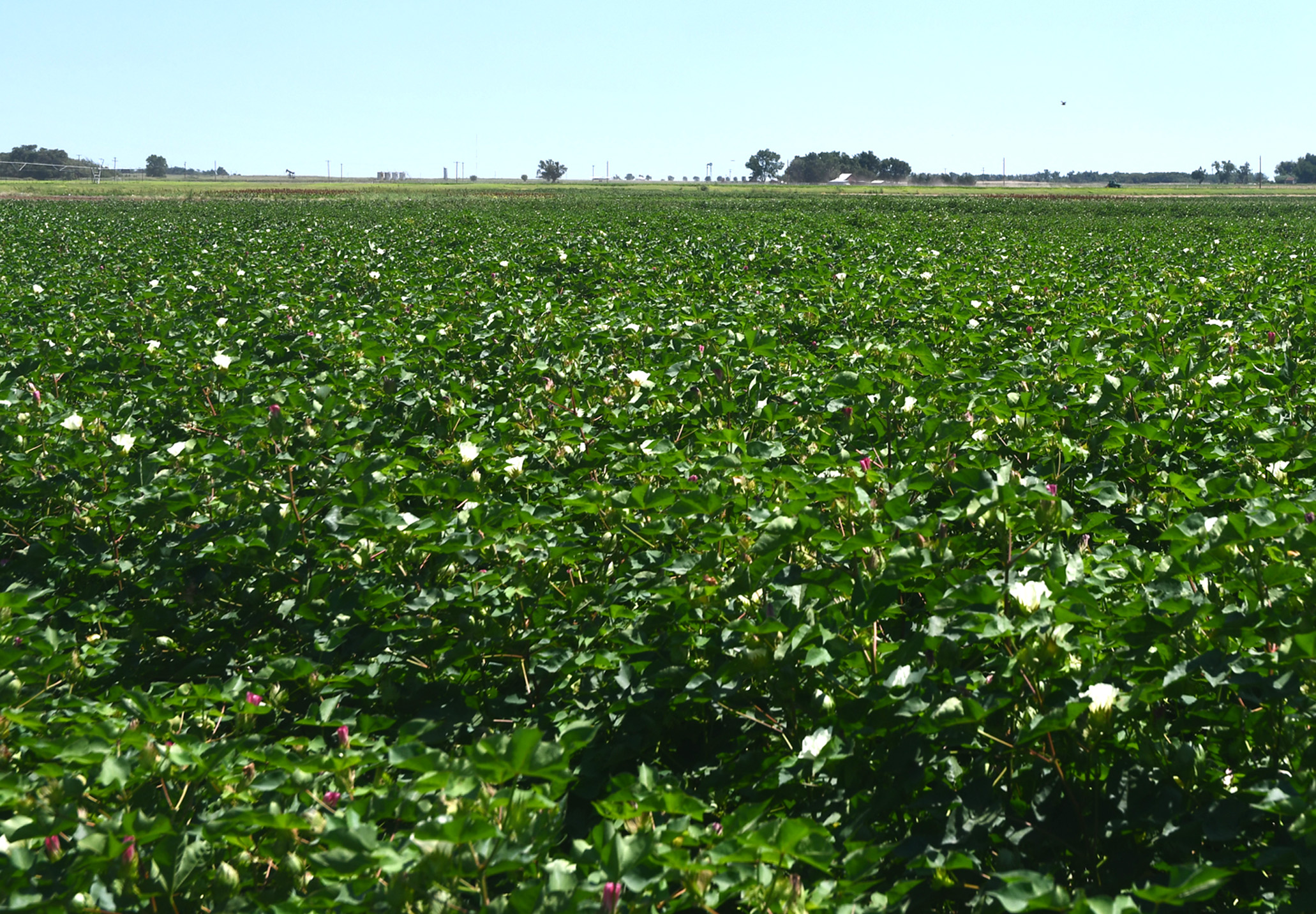Farm & Ranch
[AgriLife Today] Hold the water: Expert says wait until cotton flowering stage to irrigate

By: Kay Ledbetter
Writer: Kay Ledbetter, 806-677-5608, [email protected]
Contact: Dr. Paul DeLaune, 940-552-9941, [email protected]
CHILLICOTHE – Almost five years of data indicate producers can save as much as 40 percent of their water on a cotton crop by better timing their irrigation, according to a Texas A&M AgriLife Research scientist.
Dr. Paul DeLaune, an AgriLife Research environmental soil scientist at Vernon, has conducted long-term conservation tillage and irrigation studies at the AgriLife Research-Chillicothe station since 2008.
He discussed these studies during the Rolling Plains Summer Field Day Aug. 30 in Chillicothe.
The tillage treatments included four treatments: conventional tillage, strip tillage, no-till and no-till with a terminated wheat cover crop. In the last five years, DeLaune also began looking at irrigation timing and amounts to determine: “Should we start watering soon after planting, or should we wait until a critical growth stage?”
He said with the growing concern over declining water resources and availability and competing water users, it is critical to determine the best time to apply that water, especially in areas of a declining aquifer.
The study compared early season irrigation, starting with 0.2 inch per day applied beginning after planting when the stand is established and continuing on, to waiting until the crop reached a critical growing stage – in this case flowering. The two treatments tested after flowering were 0.2 inch per day after flowering and 0.25 inch per day after.
These all provided a nice range of low, medium and high irrigation regimes, he said.
“What we’ve found over the last five years is the early irrigation, the banking of water, is not paying off and is a waste of water resources that has not shown up in improved yields or increased soil water profile,” DeLaune said.
He said Jim Bordovsky, AgriLife Research senior research scientist and engineer, Lubbock/Halfway, has observed similar results at Halfway and has conducted more extensive research dealing with irrigation rates and timings.
“On a four-year average, the high irrigation treatment has resulted in 27 percent more water use compared to the medium treatment and 42 percent more water use compared to the low treatment,” he said. “Yet, we have observed no statistical differences in lint yields among irrigation treatments, with yields within 10 percent of each other among treatments.”
Additionally, he said, they have noticed more water is conserved, and fields have higher irrigation water-use efficiencies under no-tillage and no-till with a cover crop regime.
“Our yields over a four-year average have been statistically higher for those no-till systems than both strip tillage and conventional tillage, at least 9 percent higher,” DeLaune said.
“So combining conservation tillage with proper irrigation management and timing can conserve water resources and improve your yields and economic returns.”
-30-
Find more stories, photos, videos and audio at http://today.agrilife.org
Farm & Ranch
Acorn Toxicity

By Barry Whitworth, DVM, MPH
With the prolonged drought, most pastures in Oklahoma end up in poor condition. With the lack of available forage, animals may go in search of alternative foods.
If oak trees are in the pastures, acorns may be a favorite meal for some livestock in the fall. This may result in oak poisoning.
Oak leaves, twigs, buds, and acorns may be toxic to some animals when consumed.
To read more, pick up a copy of the November edition of North Texas Farm & Ranch magazine, available digitally and in print. To subscribe by mail, call 940-872-5922.

Farm & Ranch
Silver Bluestems

By: Tony Dean
There are a handful of grasses on North Texas grazing lands ranchers need to know, not because they are highly desirable, but rather because they are not of much value. I call them “decom” plants, which is am acronym for “Don’t Ever Count On Me.” Silver bluestem is a “decom” grass.
Silver bluestem is a perennial which grows in all areas of Texas. It can survive in almost all soil types, and in full sun conditions or in semi shade. It grows up to three feet tall and is easily recognized with the presence of the white fuzzy seed head. Also, one of the identifying characteristics of Silver bluestem is a bend in the stems at each node, causing the plants to take on a rounded shape as they mature.
To read more, pick up a copy of the November edition of North Texas Farm & Ranch magazine, available digitally and in print. To subscribe by mail, call 940-872-5922.

Farm & Ranch
Meanwhile Back At The Ranch

By: Rayford Pullen
Fall is here which means winter is closing in on us and before we officially get into winter, we need to make sure our factories are either producing or will be producing in a few months.
We have been pregnancy testing our cows this fall and if they are not bred or nursing a calf, we are bidding them adios. With annual costs somewhere between $900.00 and $1,000.00 per cow, those cows not producing a live weaned calf are costing us quite a bit.
To read more, pick up a copy of the November edition of North Texas Farm & Ranch magazine, available digitally and in print. To subscribe by mail, call 940-872-5922.
-

 Country Lifestyles2 years ago
Country Lifestyles2 years agoScott & Stacey Schumacher: A Growth Mindset
-

 Country Lifestyles8 years ago
Country Lifestyles8 years agoStyle Your Profile – What your style cowboy hat says about you and new trends in 2017
-

 HOME8 years ago
HOME8 years agoGrazing North Texas – Wilman Lovegrass
-

 Equine1 year ago
Equine1 year agoThe Will to Win
-

 Country Lifestyles5 years ago
Country Lifestyles5 years agoAmber Crawford, Breakaway Roper
-

 Outdoor9 years ago
Outdoor9 years agoButtercup or Primrose?
-

 Country Lifestyles8 years ago
Country Lifestyles8 years agoJune 2016 Profile – The man behind the mic: Bob Tallman
-

 Country Lifestyles8 years ago
Country Lifestyles8 years agoDecember 2016 Profile, Rusty Riddle – The Riddle Way




